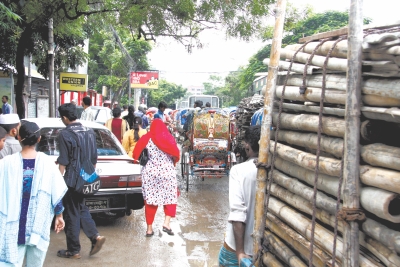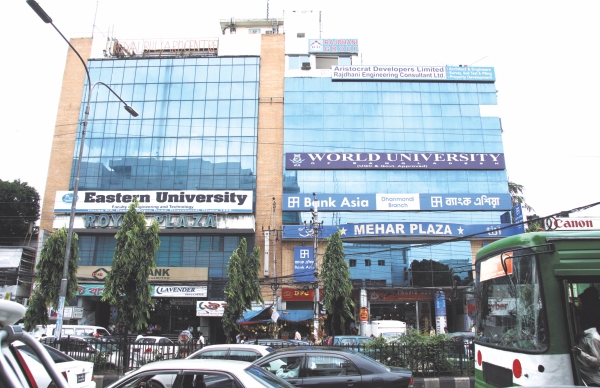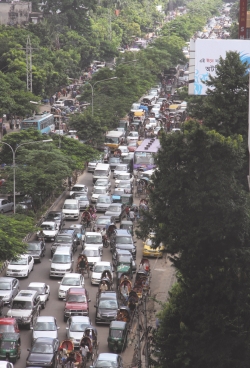| Home - Back Issues - The Team - Contact Us |
 |
| Volume 11 |Issue 27| July 07, 2012 | |
|
|
Special Feature The Dhanmondi Dream In light of the recent High Court verdict declaring all commercial operations
in the residential area illegal, is a different Dhanmondi actually possible? Sushmita S Preetha
Cars crawl down the two narrow lanes in 10/A, zigzagging around rickshaws and fruit-sellers idling outside of schools. The school bell rings auspiciously, and in a moment, the street bursts with the innocent exuberance of children, clambering to get out in the free air. But their excitement is all but lost amid the loud profanities of drivers and rickshaw-pullers and the deafening honks of innumerable cars, each competing with the others to creep an inch forward. Double parked cars on each side of the road unapologetically block the entire flow of traffic. There is no movement in, and no movement out – even on foot, one has to manoeuvre through a semi-impenetrable maze of peddlers, garbage and moms waiting impatiently for their charge. It's a typical day in Dhanmondi, and for Dhanmondi dwellers, it's not their first or the last jam of the day – not by a long shot. “Yesterday, I spent not less than five hours stuck in traffic just within Dhanmondi – one hour in the morning, two hours in the afternoon, and another two hours in the evening,” complains Shafina Talukdar, an executive in a private bank. “I was just telling my mom the other day to never get a heart-attack during school time because there would be no way to get her to a hospital. It's a complete mess,” adds her daughter, Rutba, a college student. With every passing day, the situation in Dhanmondi only seems to get worse. Long gone are the days when Dhanmondi was a serene residential area, with picturesque two-storied houses, open green fields and clean jam-free roads. The Dhanmondi now, with its high-rise shopping malls, restaurants, hospitals, banks, schools, beauty parlours and universities, and the constant cacophony of people and vehicles, looks markedly different from the once exclusively residential locale it was designed to be. As Shaikat Ali, a retired engineer, reminiscences, “I spent my whole life in Dhanmondi, but I no longer recognise it. Back in the days, there were no shops, malls or supermarkets – there was just one small grocery store called Chotrola. Dhanmondi was such a beautiful place – it was safe and secure. My children used to play on the streets and I never worried about them.” The landscape began to change in the 1990s, with different schools and shops setting up their premises in Dhanmondi, hoping to capitalise on the area's prime location. “We weren't so sceptical of the businesses in the beginning though. It was useful to have everything so close by. We were happy we wouldn't need to go to Motijheel or Elephant Road to do our banking or shopping,” Shaikat opines. But then, things started to spin out of control, with commercial enterprises mushrooming in every corner of the area, competing with each other to attract more and more customers. At present, nearly half of all plots in Dhanmondi are used for commercial purposes, including government and semi-government offices, showrooms and warehouses of business firms, art galleries, and even manufacturing units. According to a recent survey, there are 57 clinics and 26 universities in the area, covering about 500 acres of land. The free play of market forces has given Dhanmondi an extreme make-over – it now resembles more a commercial area interspersed with a few residences than a residential area with a handful of businesses.
Recently, however, some Dhanmondi-dwellers have taken matters into their own hands and formed a group called the Dhanmondi Residential Welfare Association. On behalf of the Association, MA Masud, president, and MA Matin Chowdhury, general secretary, filed a writ petition in 2011, asking the High Court to take necessary directives for protecting the residential character of the area. MA Matin Chowdhury explains, “After we filed the writ, the high court gave an injunction to the effect (on February 2011) that no new institutions should be allowed in Dhanmondi residential area. Then we tried to get a hearing. After the hearing, the HC gave orders saying that no new institutions should be set up and that existing institutions should be removed from Dhanmondi as soon as possible with the help of RAJUK and the Public Works Department.” The HC delivered the verdict after holding hearing on the rule issued earlier in February 2011 asking the government to explain why it should not be directed to evict the commercial institutions from the residential area. The ruling was issued in June 11, and there still seems to be a lot of confusion among different actors regarding what the directive actually says, who it targets and how and when the decisions will be implemented. Most institutions say they have not received any official notice from the government authorities, and hence do not know if and how they will be affected by the HC decision. Prof Dr Iffat Chowdhury, Registrar of University of Development Alternative (UODA), states, “We have not received any documents; we have only seen the decision in the papers. They have asked Maple Leaf International to move, but they have not said anything to us yet.” The administration of Mastermind School claim they do not know anything either. “Besides, we have our own premises, so I don't think the ruling applies to us. It's only applicable for institutions that are renting the places,” argues Masuma, head administrator, dismissively. However, petitioners' counsel Manzil Murshid explains that it does not matter whether the commercial institutions have rented the property or own it; since the HC verdict renders all commercial entities in Dhanmondi illegal, unless the premise has permission to be a commercial building (e.g. a shopping complex), it will have to move. Maple Leaf International School, the defendant in the writ petition, has been asked to relocate from Dhanmondi within the next three years. In addition, they have been directed to use their own people to maintain the traffic in the area. Ali Karam Reza, the Vice-Principal of the school says, “We were not asked to move all our sections – just the section in Road 11/A. We accept the High Court's decision, but we must remember that it also implicates all commercial institutions. If all of them move, we will also relocate.”
It must be emphasised that if the HC order is implemented, every business in Dhanmondi, except for those in Road 27, Shatmasjid Road and Road 2, will be removed, including tailors, small grocery stores and laundries. Not surprisingly, many business owners and employees are concerned about their future. As Razia Sultana, owner of Dreams Beauty Parlour, says, “We wish they had told us before we invested so much money on our new establishment; now, suddenly, if we have to move, it puts us in a really difficult place. We are in a lot of tension about this. This is our own property, so it's a big problem.” Razia is nervous because she has received a notice from Rajuk, but many others, who have not received an official notice, seem to take the news of the HC order lightly. On conditions of anonymity, the director of a coaching centre says, “This is Bangladesh. I am sure nothing like that will actually happen. The issue will either be forgotten in a little while or we will find a way to bend the rules.” Meanwhile, the authorities seem to have no clue as to what needs to be done and what their functions vis-à-vis the proposed directives will be. Saidul Rahman, an official from Dhaka South City Corporation (DSCC), states that it is not their responsibility to oversee the removal of commercial establishments. When asked about trade licenses and illegal businesses, he claims, “We have not been issuing trade licences for four or five years now. It is not up to us to see how many businesses there are that are operating without a trade licence. We don't give any commercial businesses without a commercial purpose. PWD and Rajuk are in charge of that, so we can't do anything about it.” If Saidul's account is accurate, then no new commercial institution or their branches should have been established in Dhanmondi over the past five years. But we all know that new businesses have been set up. Many of them are illegal, but Rajuk and PWD have consistently turned a blind eye towards their illegitimate operations. Meanwhile, many of them have official trade licenses and are paying regular taxes. After all, there are ways to get a trade license by bending the laws, rules and regulations and the moral compass of the officials of DSCC and Rajuk. When asked to speak on the HC directive, Rajuk officials maintain that the Dhanmondi area is under the jurisdiction of the Public Works Department. Meanwhile, PWD asserts that it has not as yet received any directives or orders from the government, so it has not been able to take any steps or notify anyone. Under the circumstances, there is a fear that the issue, like everything good in Bangladesh, will get lost amid a sea of bureaucracy and mismanagement. There is also the question of whether it is feasible, given the nature of urban development and population growth in a city like Dhaka, to relocate businesses outside of Dhanmondi and turn it into a residential area once again. Besides, as many business owners point out, Gulshan and Banani are also residential areas; why should only those in Dhanmondi have to bear the brunt of the HC? On the other hand, Dhanmondi dwellers can ask if much will change within Dhanmondi if the major shopping complexes, supermarkets, universities and hospitals – most of whom are located on Road 27, Road 2 or Shatmasjid Road – are allowed to carry on their businesses. It's too soon to tell what, if anything, will come out of the HC directive, especially if a different government comes to power. But whatever happens, let's hope Dhanmondi-dwellers can find a sustainable way to deal with the everyday anarchy and insanity that characterise their lives.
|
||||||||
Copyright
(R) thedailystar.net 2012 |


